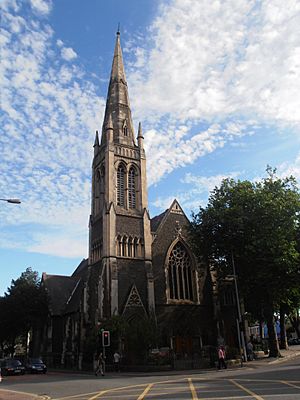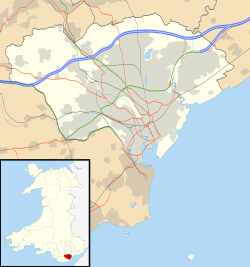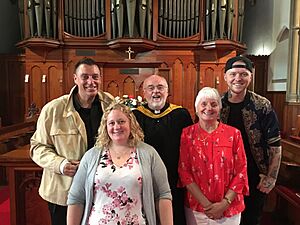St Andrews United Reformed Church, Roath facts for kids
Quick facts for kids St. Andrew's, Roath |
|
|---|---|
| St. Andrew's United Reformed Church | |
 |
|
| 51°29′46″N 3°09′52″W / 51.4960°N 3.1645°W | |
| Denomination | United Reformed Church |
| Previous denomination | Presbyterian |
| Weekly attendance | 50 |
| Website | Church Website |
| History | |
| Former name(s) | Roath Park Presbyterian Church |
| Status | Active |
| Founded | 1897 |
| Dedication | St Andrew |
| Architecture | |
| Heritage designation | Grade II* |
| Designated | 19 May 1975 |
| Architect(s) | Habershon & Fawckner |
| Style | Gothic Revival |
| Groundbreaking | 1899 |
| Completed | 1900 |
| Construction cost | £11,000 |
| Specifications | |
| Capacity | 840 |
| Number of spires | 1 |
| Spire height | 46 metres (150 ft) |
| Materials | Stone |
St. Andrew's United Reformed Church is an old church in the Roath area of Cardiff, Wales. It was built a long time ago, in the 1800s. You can find it on the corner of Wellfield Road and Malborough Road. Some people even call it the 'church on the corner'! This church serves the communities of Roath and Penylan.
Contents
Church History: From 1897 to Today
How St. Andrew's Church Started
In the late 1800s, the city of Cardiff was growing fast. The main Presbyterian church in the city centre was getting too full. So, people decided to build a new church in a quieter, more suburban area.
In 1895, they found a spot on Wellfield Road, which was mostly fields back then. A smaller chapel was built there and opened in 1897. This building is now the church hall. So many people came to the new chapel that plans were made just two years later for a much bigger church.
Building the Main Church
It was quite easy to raise the money needed for the new, larger church. The main church building opened on June 20, 1900. It was first called the Roath Park English Presbyterian Church. The main entrance looks like the one at Tintern Abbey, a famous old ruin. The big window on the west side is similar to one at Melrose Abbey.
Many of the first church members were from Scotland. The church even had a boy scout group that wore kilts! The church was most popular just before the First World War.
St. Andrew's During the Wars
During the First World War, the church lost many of its members and scouts. After 1918, about 200 people still attended regularly. The church was lucky during the Second World War. Even though a bomb fell nearby, the church building was not damaged. The church canteen served over 100 people every day during the war. It's even said that the church's collection plate was used to help pay for supplies!
Changes After the Wars
After the wars, the way the church held services changed. They stopped having evening services every week. The church no longer has a choir, but it still has a small Sunday school for children.
In 1972, the Presbyterian church joined with another group called the Congregationalists. That's when it became St. Andrew's United Reformed Church. Since 1975, the church has been a Grade II* listed building. This means it's a very important historical building. Like many churches, fewer people attend now, but it still has a strong community. Most of the people who attend are older, but some families come for Sunday services too.
The current minister, who leads the church, is Rev'd Des Kitto.
Church Buildings and Features
The Main Church and Hall
The building that is now the church hall was the first chapel, built in 1897. The larger main church building was finished in 1900. Inside the main church, there is a large Harrison & Harrison Organ that was put in place in 1900.
The main church can seat 500 people on the ground floor. There's also a balcony above that can seat another 200 people. You can get to the balcony from the narthex, which is the main entrance lobby. In 2012, the church had new electrical wiring installed. In recent years, new heating systems have also been put in.
Using the Church Hall
The church hall is a busy place! It's used as a canteen, a space for activities, and a meeting place for different groups. During Sunday services and throughout the week, it also serves as a crèche for young children. The hall has a balcony too, but it can only seat about 50 people. There are many smaller rooms off the hall, like the "South Room," which is used for quiet prayer and thinking.
Events and Community Activities
Regular Services and Holidays
The church holds services every Sunday. On the first Sunday of each month, they have holy communion services. About 50 people usually attend each service. A service includes four or five hymns, readings from the Bible, a short message or activity, a sermon, and a time for quiet prayer. Children often leave before the sermon to join the junior church in one of the side rooms.
The church also celebrates Christian holidays like Christmas and Easter. At Christmastime, they have a special 'toy service'. People bring new toys, which are then given to a charity that helps less fortunate families. They also have a midnight service on Christmas Eve and a service on Christmas Day. The church also holds Remembrance Sunday services with St. John's Ambulance.
Community Hub and Groups
The church is a lively place for the community. It hosts a pop-up shop every November and December called 'Cards for Good Causes'. The money raised from selling cards goes to many different charities.
Many groups and organizations use the church every week. These include dance classes, yoga, Zumba, Bible study groups, a play group for toddlers, and the Women's Institute. The church is also home to a very active Scout Group, the 25th Cardiff (1st Cardiff Scottish). This group has Beavers, Cubs, and Scouts who meet weekly.
The church has also become a popular place for concerts. Bands like Cardiff-based Hegsy and The Elements and choirs such as the Cwmbach Male Choir have performed in the main church area.



